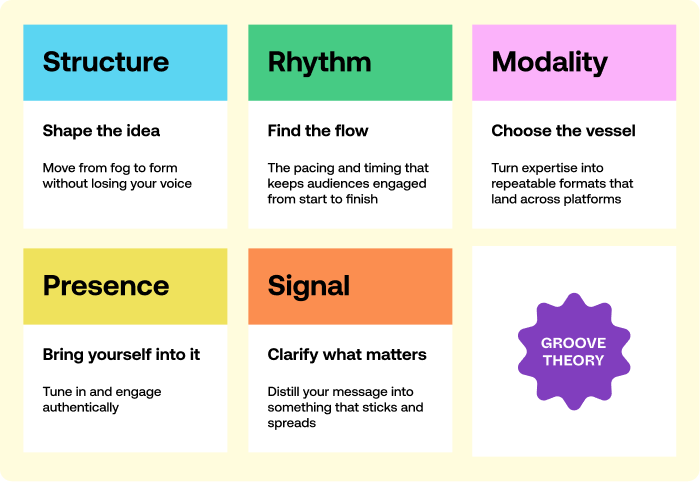Groove Theory #12 - The Maze Maker
I'm your host, Howard Gray, founder of Wavetable - the experiential learning studio.
Currently: building a playable case study in homage to Boiler Room and High Snobiety; gearing up for my first visit to Dubai and Doha
Thursday evening in England, mid 90s. I'm staying up a little later than usual. TV is set to Channel 4.
On the screen is a crazed figure in leopard print and cowboy boots, playing harmonica, shimmying around a vast wonderland. I’d never seen anything like it.
The Crystal Maze was the biggest game show on British TV. Six contestants, four themed zones, four game categories, each game a timed challenge in a locked room. Get the crystal, get out before time runs out, or you're trapped. All building toward one final challenge in a dome with fans blowing gold tokens everywhere. Hosted by Richard O'Brien of 'Rocky Horror' fame, who'd wander off mid-game to deliver deadpan asides about his fictional mother, Mumsey.

I was glued. Not for the contestants. Not even for O'Brien's faux cheetah jackets. But for the world. For the games.
Some looked impossible. Some looked easy. Most fell somewhere between. You never quite knew which until someone stepped inside.
Behind it all was Jacques Antoine. Over 40 years, he created 150+ TV and radio games - from helicopter treasure hunts to fortress challenges. His colleagues called him "the most innovative man we have had in this profession since the war." But outside his native France, hardly anyone knows who he was.
His real genius? Understanding how difficulty calibration creates presence. That the barely possible beats the perfectly achievable every time.

The Tension
Game shows had always leaned one way or the other. Too easy? Viewers check out. Too hard? Watching people fail repeatedly isn't entertainment.
Most game shows dodge this by making everything achievable or using elimination to hide failure. Antoine did neither. He designed for balance
The Crystal Maze games were deceptively simple. One task per room. Collect a crystal. You could see what to do in seconds. But doing it? That was another story.
Two games - "Nuke Defusing" and "Balls on Holes" - were never solved across six series. Meanwhile, 29 other games posted perfect 100% win rates.

Antoine knew this. It was intentional. If everything's solvable, tension dies. If nothing's solvable, hope dies. The impossible games made the barely-possible ones feel like victories.
Producer Malcolm Heyworth later admitted the "frustration factor" was deliberate: “People at home would shout "It's easy! You just do that. Turn the corner, you fool!"
The games looked simple enough that viewers believed they could do it. That belief kept them watching.
That's the zone Antoine mastered: crystal clear, barely possible.
Step Into It
Think about the last thing you set up for a group. A project brief. A workshop. A design challenge.
Too easy? Trust erodes. Too hard? People get frustrated.
Most of us oscillate. We're afraid of people failing, so we lower the stakes. Or we're trying to impress, so we add complexity. (yup, guilty).
Antoine did neither. He understood something else mattered just as much as difficulty: the vessel itself.
The Groove: Modality
Modality → The vessel you choose shapes what's possible.

Jacques Antoine figured out that the mode matters as much as the task. Same goal every time: get the crystal in 2-3 minutes. But watch what the vessel does:
- "Magnet Crane" (Skill): The crystal sits six inches away. Grab the electromagnetic crane controls. Lower the magnet. Easy. Except the slightest touch sends it swinging. Overcompensate and it swings harder. Now you're chasing metal around a room with a magnet that responds to your panic. Your hands are the problem.
- "Water Sacks" (Physical): Archery targets behind water-filled bags. Hit the target, get the crystal. But the bags are translucent—you can barely see through. Every arrow that hits moves the bag, changing your aim point. Simple archery becomes fluid physics you can't predict.
- "Shadow Play" (Mystery): Objects cast shadows on a wall. Match the shadow to the real object to unlock the crystal. Except the shadows are distorted, overlapping, deliberately misleading. What looks like a teapot might be three things stacked together. Your spatial reasoning keeps failing you.
And then there's the ultimate vessel: the lock-in. Run out of time in any room, you get locked in. And in some, the door seals automatically if you make more than two mistakes. You're trapped, as your team debates: sacrifice a crystal to free you, or continue without you?
Notice the pattern? Antoine didn't make the puzzles harder. He made the interface betray you. You understand the task perfectly - that's the "crystal clear" part. But the vessel introduces a second challenge: the magnet swings, the water moves, the wheels stick. He's layering difficulty through the mode, not the problem itself. This is why contestants would shout "I KNOW what to do!" while failing. The knowing and the doing got separated by the vessel.
1. Make it clear, not easy
Antoine's games required almost no explanation. You could see what to do immediately. But doing it was another story. Clarity doesn't equal simplicity. Give people a challenge they can understand in seconds but might not solve in minutes.
2. Design for some failure
Only 22% of teams won The Crystal Maze overall. That wasn't a bug. If everyone wins, nothing matters. If no one wins, why try? Antoine designed for the zone where both outcomes felt possible. Some of his games were never solved. Some were solved every time. The mix created the pattern.
3. The vessel does the work
Different time-keeping systems for different zones. Thresholds that required physical action to cross. Lock-ins that made stakes real. These weren't decoration - they were the experience. The mode you choose shapes what people feel, not just what they see.
Modality is one of the five elements of Groove Theory. Learn more →

The Release
Jacques Antoine died in 2012. The Crystal Maze Live Experience still runs in London and Manchester. People pay to get locked in rooms. To feel the clock tick. To discover if they can do something that looked simple but might not be.
Antoine figured out the calibration. Just enough instruction to understand. Just enough difficulty to make it matter.
It's not only a game show format. It's what you do when you set up a workshop. When you write a project brief. When you create space for a group to discover what they can do.
You're calibrating difficulty. Choosing vessels. Designing for the edge where both outcomes feel possible.
You're a game designer.
Howard
Extended Mix: Maze Making
- A 48-hour pivot: When Channel 4 commissioned a British version of Antoine’s ‘Fort Boyard’ in 1989, the Napoleonic fortress was unavailable - still under renovation. Antoine and producer Malcolm Heyworth had 48 hours to propose an alternative. They invented something different: four themed zones around a central crystal dome. The constraint that could have killed the commission created The Crystal Maze instead. Sometimes the backup plan becomes the breakthrough.
- D&D translation: Antoine adapted Fort Boyard from Dungeons & Dragons. The Crystal Maze took it further - host as Dungeon Master, team as adventuring party, lock-ins as party member losses. When adapting frameworks across mediums, map the structural elements (exploration, resource management, risk/reward), not the surface aesthetics. And remember - everything's a remix.
- Head & Legs legacy: Antoine's 1960 breakthrough "La Tête et les Jambes" paired one contestant answering questions with another doing physical challenges. Every show he created after kept this pattern. Whole-person engagement beats single-mode challenges.
Ready to build the right formats for your biggest moments?
Groove Build helps you turn your expertise into best-in-class keynotes, workshops, and programs Start with a single 1:1 session, or dive deeper.
No spam, no sharing to third party. Only you and me.

Member discussion